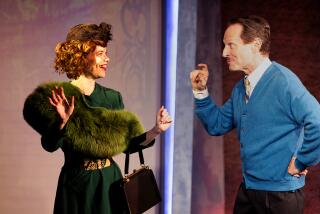Alone in the moment
- Share via
When I first read about the John Cassavetes retrospective, I couldn’t wait for the chance to watch a collection of rarely seen TV programs -- many of them shot live -- from his youthful acting days. I arrived early for the screening, at the Museum of Television & Radio in Beverly Hills, anticipating a crowd of fans.
Alas, my view was undisturbed for aisles. By the time the show started, four other people had turned up. Where were the aspiring actors, directors and hipster cineastes?
Cassavetes (1929-1989) is a legend among independent filmmakers. From his first movie, “Shadows” (1960), he directed films on his own terms. His work gained recognition from the film community, garnering Oscar nominations for “Faces” and “A Woman Under the Influence.” But his insistence on working without studio interference, and his passion to portray smaller human stories without the usual Hollywood plot lines and happy endings, set him outside the mainstream.
Indeed, he was probably more well known to the general public as a movie actor, in films ranging from “Rosemary’s Baby” to “The Dirty Dozen” (which earned him an Academy Award nomination for best supporting actor).
But long before his movie career, Cassavetes was a staple on TV shows in the 1950s.
“There’s this popular myth that Cassavetes did his serious work in film, and television was merely a stepping stone,” curator Allen Glover says by phone from MTR in New York.
But by the time Cassavetes began shooting “Shadows” in 1957, he’d appeared in at least four dozen live TV productions. The MTR series, which is screening concurrently at the museums’ New York facility, also includes a number of shows that he directed.
These programs helped shape Cassavetes as a filmmaker. “The way the camera follows the actors, not the other way around, that’s very important to note,” Glover says. “The way that the performances seem improvised, but in fact were very tightly rehearsed; the way the emotional tension builds and builds -- these are all hallmarks of the live television drama.”
According to Glover, if it weren’t for Cassavetes’ fame as a television actor, he would never have been able to make “Shadows” in the first place. (And if it weren’t for the rigidity Cassavetes found in the studio system, with its dependence on sponsors, censors and ratings, he might not have been so determined to break out of it.)
So what’s with the empty seats?
At first I thought maybe it was the 3 p.m. showtime. People can’t just take off in the middle of the day. But as I drove to the museum for another screening I passed a coffeehouse packed with people -- some staring at their laptops, others staring at their lattes. In other words, film people.
Granted, the museum has no advertising budget for the series. But neither that nor the timing can explain why the New York shows are reporting much larger crowds. (OK, “crowd” may not be the word to describe 30 to 40 attendees on weekdays, maybe 50 on weekends. But it beats the L.A. five.)
Glover posits another theory: “I think people tend to gloss over television when they talk about a great director,” he says, adding that if the series were playing in a film museum like Film Forum in New York or Hollywood’s Cinematheque it might be drawing a bigger audience.
It’s not only Cassavetes fans who would benefit from the series, but anyone interested in great acting, such as, say, actors. As one might expect from teleplays made in the ‘50s and ‘60s (with one “Columbo” episode from 1972), some of the shows are incredibly dated. But regardless of what’s going on around him, Cassavetes is nothing short of riveting.
Iris Klein, an acting teacher whom I encountered with her family after one screening, is more than a fan -- she worked with Cassavetes on his play “A Woman of Mystery” in 1987. She has been exhorting her students to attend the series, because “he’s fearless.”
“He completely embraces every moment and every being he works with -- emotionally, physically, mentally, spiritually.”
Klein’s mother, acting teacher and coach Janet Alhanti, also had a role in the play, and considers working with Cassavetes one of the most extraordinary experiences of her life. Reached by phone, Alhanti -- who counts Diane Lane, Naomi Watts, Tobey Maguire and Ashlee Simpson among her clients -- rhapsodizes about Cassavetes’ energy, his “wildness.”
She wants her students to learn from the way he interacted with the rest of the cast. “John was a team player. That’s very rare today -- you come in, you work and you leave. There’s not that sense of camaraderie now.”
Another draw is seeing the other players on the Cassavetes team. Big names who worked on the early shows include directors John Frankenheimer and Sidney Lumet, writers Steven Bochco and Robert Towne, and actors Martin Landau, Blythe Danner, Ronald Reagan, Cloris Leachman, and Lee Marvin, in addition to those who became his regular film cast members -- Peter Falk, Seymour Cassel, Ben Gazzara and Cassavetes’ wife, the stunning Gena Rowlands.
I’d be remiss not to also duly note Cassavetes’ physical appeal as well. As Iris put it, “So, so sexy, gorgeous, handsome, beautiful. Wow, huh?”
Exactly.
What more does anyone need? Go on inside and watch TV in the middle of the day, it’s good for you.
*
For more information, call (310) 786-1000 or visit www.mtr.org.
More to Read
The biggest entertainment stories
Get our big stories about Hollywood, film, television, music, arts, culture and more right in your inbox as soon as they publish.
You may occasionally receive promotional content from the Los Angeles Times.










